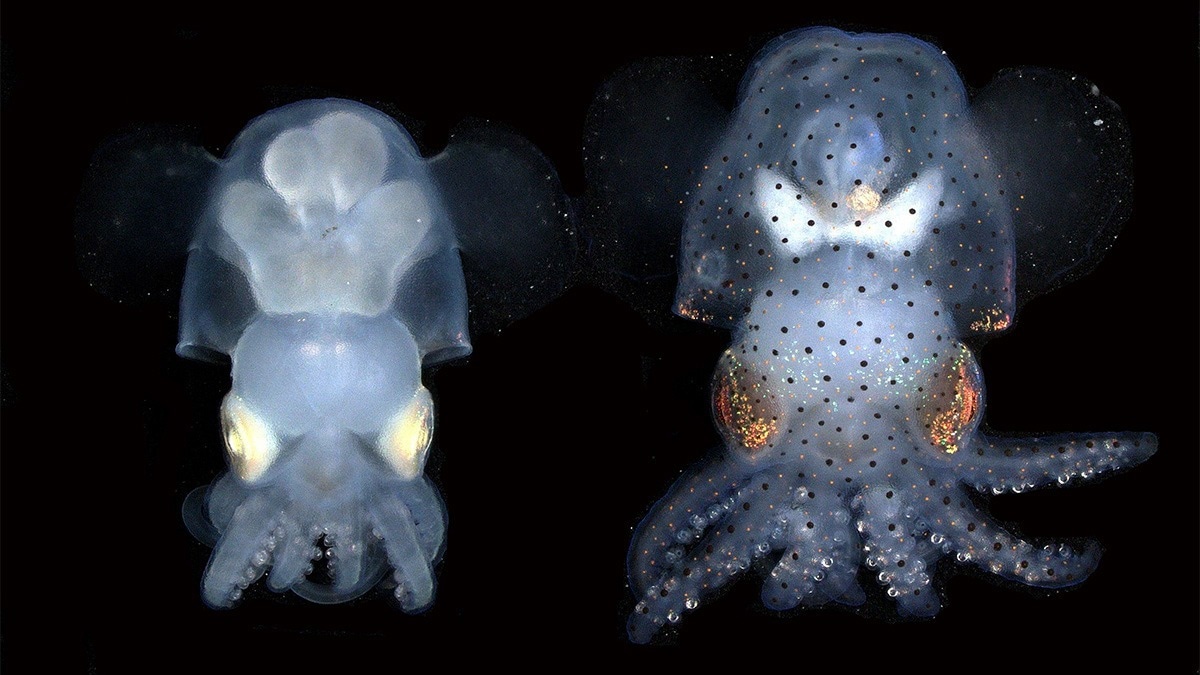Reviewed by Danielle Ellis, B.Sc.Jun 21 2023
A team of researchers at the Marine Biological Laboratory (MBL) has successfully engineered an albino strain of Euprymna berryi, the hummingbird bobtail squid.
 Albino (left) and wildtype (right) hummingbird bobtail squid (Euprymna berryi) hatchlings. Ahuja et al. created a strain of bobtail squid that deactivated two genes that produce pigment in the skin and eyes. Image Credit: Carrie Albertin & MBL Cephalopod Program.
Albino (left) and wildtype (right) hummingbird bobtail squid (Euprymna berryi) hatchlings. Ahuja et al. created a strain of bobtail squid that deactivated two genes that produce pigment in the skin and eyes. Image Credit: Carrie Albertin & MBL Cephalopod Program.
This achievement, published on June 20th, 2023, in the Current Biology journal, produced a nearly transparent organism that allows scientists to visualize the nervous system in a living cephalopod for the first time.
It is also the first time a genetically altered cephalopod has been bred across multiple generations, demonstrating E. berryi’s enormous potential as a cephalopod model organism for neurobiological and other forms of research.
There’s a whole lot of incredibly interesting biology surrounding cephalopods, unlike any other invertebrate. We now have a model cephalopod where we can interrogate biological function at much higher resolution than before.”
Joshua Rosenthal, Senior Scientist, Marine Biological Laboratory
Joshua Rosenthal co-led the study with MBL Hibbitt Fellow Caroline Albertin.
Coleoid cephalopods (squid, octopus, and cuttlefish) have a significantly more complicated nervous system and behavior than most invertebrates. Cephalopods can learn and recall complex tasks: they solve mazes, use tools, and even learn by observing others. They can instantly camouflage, influence their surroundings with their arms and tentacles, and acclimatize to a colder environment by substantially editing their own RNA, according to a recent MBL study.
What cephalopod investigations have missed is a model organism that can be genetically studied. While decades of research into fruit flies and mice have revealed the genetic basis of development, behavior, and evolution in those animals, a lack of tools to explore cephalopod biology has resulted in a restricted understanding of these interesting animals.
This new study suggests Euprymna berryi as a suitable candidate for a model cephalopod since it is easy to breed in a lab over generations and can be genetically altered.
“The ability to directly and precisely test gene function in a model cephalopod is exciting because it makes it possible to study the features that make cephalopods special - and it will be an important tool for understanding many different aspects of their unique biology,” notes co-author Albertin.
The albino lineage of E. berryi was made by disabling the genes for two pigmentation enzymes with CRISPR-Cas9 genome editing. The albino squid’s brain activity was then studied by co-authors Cris Niell of the University of Oregon, Eugene, and Ivan Soltesz of Stanford University by introducing a fluorescent dye into its optic lobe.
This dye glows whenever it recognizes calcium, which is released by the brain when it fires. Scientists then projected a succession of images onto a screen in front of the squid, activating its optic lobe and causing the dye to light up, which was all captured using an imaging microscope. When the researchers tried the same procedure on a wild-type squid, their skin color made it impossible to view the dye properly.
This discovery “allows us to look at gene function and cephalopod brains in ways we couldn't before,” says Rosenthal. If other researchers wish to understand more about how signals are transmitted through cephalopod brains, they can now breed albino squid and conduct similar experiments using calcium-activated dye.
Alternatively, if a researcher wishes to genetically modify these squid to examine other facets of their biology, the team’s findings show that such studies are achievable.
Rosenthal and Albertin’s team identified a novel aspect of E. berryi biology in this investigation. When the researchers deactivated the first pigmentation gene, known as TDO, they expected to produce an albino squid, as they had done with another species of squid (Doryteuthis) in previous work in 2020.
However, the subsequent E. berryi offspring were still colored. The researchers quickly discovered that the pigment was also produced by a second enzyme termed IDO, a protein previously unrecognized in cephalopods. It is uncertain why E. berryi has two enzymes that appear to accomplish the same function.
Rosenthal, Albertin, and collaborators hope that other scientists may decide to deepen their understanding of E. berryi and use it to solve some of cephalopod biology’s mysteries.
We want to see these animals shared with the research community. Cephalopods contain treasure troves of biological novelty. We want to see people using them to ask thought-provoking questions and come up with novel findings.”
Joshua Rosenthal, Senior Scientist, Marine Biological Laboratory
The hummingbird bobtail squid (Euprymna berryi). Ahuja et al. engineered the albino, on left, by deactivating two pigmentation genes. The wild type is on the right. Video Credit: Carrie Albertin and MBL Cephalopod Program.
Source:
Journal reference:
Ahuja, N., et al. (2023) Creation of an albino squid line by CRISPR-Cas9 and its application for in vivo functional imaging of neural activity. Current Biology. doi.org/10.1016/j.cub.2023.05.066.